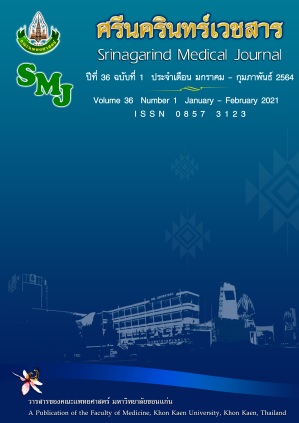Back Pain Management for Patients Underwent Transfemoral Coronary Angiography: Nurse’s Role
Keywords:
back pain, pain management, transfemoral coronary angioplasty, nurse's roleAbstract
Back pain is a common problem among patients underwent transfemoral coronary angiography (CAG). After the intervention, patient is required to stay in supine position with a straight leg for several hours to prevent vascular injury related bleeding, which consequently causes back pain. Prolong stay in supine position results in weight bearing pressure on back muscle causing back pain. Back pain management for patients underwent transfemoral CAG is a pivotal nursing role either independently or collaboratively with other professions. This paper describes mechanism of pack pain related to transfemoral CAG, pain assessment tool, pain management strategies, and nurse’s roles in pain management after CAG from a literature review, which can be utilized to provide patient care.
References
nary heart disease: the Framingham Off spring Study. American journal of epidemiology 2009; 169(7): 829-36.
2. Bakhshi F, Namjou Z, Andishmand A, Panabadi A, Bagherinasab M, Sarebanhassanabadi M. Effect of positioning on patient outcomes after coronary angiography: A single-blind ran-domized controlled trial. Journal of Nursing Research 2014; 22(1): 45–50.
3. Teirstein PS, Lytle BW. Interventional and surgical treatment of coronary artery disease. In: Goldman, L, Schafer AI, Editors. Goldman’s Cecil Me-dicine. 24th ed. Philadelphia: Elsevier/Saunders; 2011.
4. Naowapanich S. Nursing care for patient with acute Coronary Syndrome and underwent percutaneous Coronary Intervention; 2009. (In Thai)
5. Aktürk E,Kurtoğlu E, Ermiş N, Açıkgöz N, Yağmur J, Altuntaş MS,et al.Comparision of pain levels of transradial versus transfemoral coronary catheterization : a prospective and randomized study2014;14(2):140–146.
6. Sulzbach-Hoke LM, Ratcliffe SJ, Kimmel SE, Kolansky DM,Polomano R. Predictors of complications following sheath removal with percutaneous coronary intervention. Journal of Cardiovascular Nursing2010;25(3):1–8.
7. Singh Mandeep.Bleeding Avoidance Strategies During Percutaneous Coronary Interventions. Journal of the American College of Cardiology 2015 ;65(20):2225–2238.
8. Piva CD, Vaz E, Moraes MA, Goldmeyer S, Fernanda G, Souza EN.Discomfort Reported byPatients After Cardiac Catheterization Using the Femoralor Radial Approaches. Revista Brasileira de Cardiologia Invasiva, 2014; 22(1): 36–40.
9. Suksamai J,Nipatsiripol Y, Daengsri T, samai Th. Nursing clinical practice guidelines to reduce back pain for patients underwent percutaneous coronary interventions. Siriraj Nursing Journal 2011; 4(1): 56-64. (In Thai)
10. Leaungsomnapa Y, Ngamkham Sr. Attention to pain. J Prapokklao Hosp Clin Med Educat Center 2013; 30(1): 83-93. (In Thai)
11. Pianbanyat K, ChooWattanapakorn T. Pain and nursing care in older persons with cancer. Thai Red Cross Nursing Journal 2014; 7(1): 10-25. (In Thai)
12. Jessell TM, Iverson LL. Opiate analgesics inhibit substance P release from rat trigeminal nucleus. Nature 1977; 5620: 549-551.
13. Manit N. Effect of stretching exercise on low back pain and functional ability in home-based garment workers [Thesis]. Chiang Mai: Chiang Mai University; 2010. (In Thai)
14. Koontalay A.Pain management in critically ill patients:Nursing roles. Journal of Nursing Science & Health 2019; 42(2):126-136. (In Thai)
15. Burn KL, Marshall B, Scrymgeour G. Early mobilization after femoral approach diagnostic coronary angiography to reduce back pain. Journal of Radiology Nursing 2015; 34(3):162-169.
16. Van Dijk JF, Van Wijck AJ, Kappen TH, Peelen LM, Kalkman CJ, Schuurmans MJ. Postoperative pain assessment based on numericratings is not the same for patients and professionals: A cross-sectional study.Inter-
national Journal of Nursing Studies 2012;49(1)
:65–71.
17. Rezaei-Adaryani M, Ahmadi F, AsghariJafa-
rabadi M.The effect of changing position and early ambulation after cardiac catheterization
on patients’outcomes:asingle-blind randomized controlled trial. International journal of nursing studies 2009;46(8): 1047-1053.
18. Kovindha A.Textbook of spinal cord injury : comprehensive rehabilitation vol.1. Chiang Mai: sutin printing;2012. (In Thai)
19. Hassan AK., Hasan-Ali H, Demetry S R, Refaat R, Ali AS.Early sheath removal after percutaneous coronary intervention using Assiut Femoral Compression Device is feasible and safe. Results of a randomized controlled trial. The Egyptian Heart Journal, 2015; 67(1): 69-77.
20. Bashoe TM, Balter S, Barac A, Byrne JG, Cavendish JJ, Chambers CE, et al. 2012 American College of Cardiology Foundation/
Society for Cardiovascular Angiography and Interventions expert consensus document on cardiac catheterization laboratory standards update: a report of the American College of Cardiology Foundation Task Force on Expert Consensus Documents. Journal of the American College of Cardiology 2012;59(24): 2221-2305.
21. Chair SY, Thompson DR, Li SK. The effect of ambulation after cardiac catheterization on patient outcomes. Journal of Clinical Nursing,
2007; 16(1): 212-214
22. Augustin AC, Quadros AS, Sarmento-Leite RE.Early sheath removal and ambulation in patients submitted to percutaneous coronary intervention : A randomised clinical trial. Inter-
national Journal of NursingStudies. 2010; 47(8)
:939–945.
23. Cha NH, Sok S. Effects of position change on lumbar pain and discomfort of Korean patients after invasive percutaneous coronary intervention: a RCT study. Journal of physical therapy science. 2016; 28(10): 2742-2747.
24. Rolley JX, Salamonson Y, Wensley C, Dennison CR, Davidsn PM. Clinical Guideline:
Nursing clinical practice guidelines to improve care for people undergoing percutaneous coronary interventions. Australian Critical Care 2011; 24(1):18–38.
25. Olson NC. Comparison of Head Coronary Angiography. Critical Care Nurse 2016; 36(3)
:20-35.
26. Scriver V, Wilkinson A, Madowcroft C. A randomized controlled trial of the effectiveness of exercise and/or alternating air mattress in the control of back pain after percutaneous trans-luminal coronary angioplasty. Heart Lung 1994; 23(4):308-316.
27. Fereidouni Z, Kameli Morandini M, Najafi Kalyani M.The efficacy of interventions for back pan in patients after transfemoral coronary angiography: A rapid systematic review. Journal of Vascular Nursing. 2019; 37(1): 52–57.
28. Thailand Nursing and Midwifery council. Professional Nursing and Midwifery Act B.E. 2540 (1997).Bangkok: The best graphic and print; 1997. (In Thai)
29. Sattari M, Baghdadchi ME, Kheyri M, Khakzadi H, Mashayekhi SO. Study of patient pain management after heart surgery. Adv Pharm Bull 2013; 3(2):373-377.
30. Herr K, Coyne PJ, Manworren R, McCaffery M, Merter S, Kelly JP et al. Pain assessment in the nonverbal patient: position statement with clini-
cal practice recommendations. Pain Manage Nurs 2006; 7(2):44-52.




